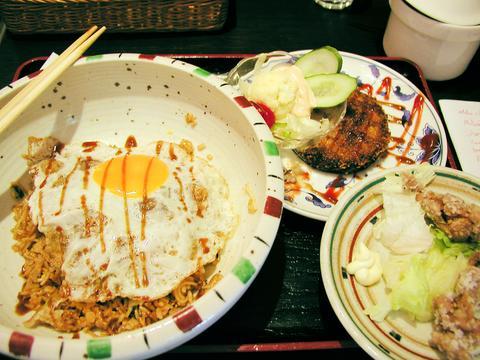Yi Fan Ting is a hip little ramen joint with three branches around town -- on Yongkang Street, Guangfu Road and Qingdao Road -- and at each you should consider yourself lucky if the wait for a table is under 20 minutes. Popularity, of course, isn't necessarily a sign of good food, but in this case, it certainly is.
The menu offers a large range of foods, but the specialization in ramen is clear, in particular the chef's signature spicy ramen. When diners sit down, they're handed a plastic fan and at first I thought this was a cheap excuse for not turning the air-conditioning up a couple of notches. It turns out that the fan comes in handy if you have the gusto take on the spicy ramen, which has cautionary flames next to it on the menu and is served with a deep ochre-tinted layer of searing spicy oil. Those who bravely (or foolishly, it's hard to tell) take on the spicy ramen challenge are identifiable by their frantic fan flapping and sweaty, beet-red faces.

PHOTO: MAX WOODWORTH, TAIPEI TIMES
But I've seen Tampopo enough times to know that superior ramen is achieved through subtlety, which could hardly describe Yi Pan Ting's spicy noodle specialty. So, if heart-stopping spice is not the experience you want for lunch or you forgot to bring a change of shirts, there are tamer offerings. The fatty pork ramen is a good place to start, with its rich broth, delicate slices of pork and a fistful of mushrooms and bamboo shoots, or the zesty
miso-based ramen. This being the dog days of summer, there are two cold noodle dishes, one with hearty soba noodles under heaps of fresh garden vegetables and another that takes its cue from Taiwan's own ground pork dan-zi noodles.
One of the more interesting dishes on offer is the Osaka fried noodles, which is actually mixed with fried rice and topped with a fried egg, making it a hefty and flavorful main course that would be perfect if it weren't a tad overly salty.
Most of the ramens and the fried noodle dishes can be part of a set meal which run between NT$210 and NT$260 and come with either a salad or chunks of fried chicken, self-serve ice cream and either coffee or tea. The set meal should satisfy most appetites, but larger hungers may seek out the fried dumplings, which are also too salty for their own good, or the Mr. Cola fried rice and beef patty. Whatever you choose, it's worth the wait, and makes the J-Pop pretty enjoyable too.

That US assistance was a model for Taiwan’s spectacular development success was early recognized by policymakers and analysts. In a report to the US Congress for the fiscal year 1962, former President John F. Kennedy noted Taiwan’s “rapid economic growth,” was “producing a substantial net gain in living.” Kennedy had a stake in Taiwan’s achievements and the US’ official development assistance (ODA) in general: In September 1961, his entreaty to make the 1960s a “decade of development,” and an accompanying proposal for dedicated legislation to this end, had been formalized by congressional passage of the Foreign Assistance Act. Two

Despite the intense sunshine, we were hardly breaking a sweat as we cruised along the flat, dedicated bike lane, well protected from the heat by a canopy of trees. The electric assist on the bikes likely made a difference, too. Far removed from the bustle and noise of the Taichung traffic, we admired the serene rural scenery, making our way over rivers, alongside rice paddies and through pear orchards. Our route for the day covered two bike paths that connect in Fengyuan District (豐原) and are best done together. The Hou-Feng Bike Path (后豐鐵馬道) runs southward from Houli District (后里) while the

On March 13 President William Lai (賴清德) gave a national security speech noting the 20th year since the passing of China’s Anti-Secession Law (反分裂國家法) in March 2005 that laid the legal groundwork for an invasion of Taiwan. That law, and other subsequent ones, are merely political theater created by the Chinese Communist Party (CCP) to have something to point to so they can claim “we have to do it, it is the law.” The president’s speech was somber and said: “By its actions, China already satisfies the definition of a ‘foreign hostile force’ as provided in the Anti-Infiltration Act, which unlike

Mirror mirror on the wall, what’s the fairest Disney live-action remake of them all? Wait, mirror. Hold on a second. Maybe choosing from the likes of Alice in Wonderland (2010), Mulan (2020) and The Lion King (2019) isn’t such a good idea. Mirror, on second thought, what’s on Netflix? Even the most devoted fans would have to acknowledge that these have not been the most illustrious illustrations of Disney magic. At their best (Pete’s Dragon? Cinderella?) they breathe life into old classics that could use a little updating. At their worst, well, blue Will Smith. Given the rapacious rate of remakes in modern